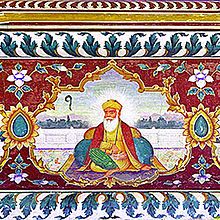 Guru Nanak ([ˈɡʊɾu ˈnɑnək],
Guru Nanak ([ˈɡʊɾu ˈnɑnək],
Guru Nanak has been called "one of the greatest religious innovators of all time".[2] He travelled far and wide teaching people the message of one God who dwells in every one of His creations and constitutes the eternal Truth.[3] He set up a unique spiritual, social, and political platform based on equality, fraternal love, goodness, and virtue.[4][5][6]
Guru Nanak's words are registered in the form of 974 poetic hymns in the holy text of Sikhism, the Guru Granth Sahib, with some of the major prayers being the Japji Sahib, the Asa di Var and the Sidh-Ghost. It is part of Sikh religious belief that the spirit of Guru Nanak's sanctity, divinity and religious authority descended upon each of the nine subsequent Gurus when the Guruship was devolved on to them.[7]
Family and early life
Nanak was born on 15 April 1469 at Rāi Bhoi Kī Talvaṇḍī (present day Nankana Sahib, Punjab, Pakistan) near Lahore.[8][9] His parents were Kalyan Chand Das Bedi, popularly shortened to Mehta Kalu, and Mata Tripta.[10] His father was the local patwari (accountant) for crop revenue in the village of Talwandi.[11] His parents were both Hindus and belonged to the merchant caste.[12]
He had one sister, Bebe Nanaki, who was five years older than he was. In 1475 she married and moved to Sultanpur. Nanak was attached to his sister and followed her to Sultanpur to live with her and her husband, Jai Ram. At the age of around 16 years, Nanak started working under Daulat Khan Lodi,[1] employer of Nanaki's husband. This was a formative time for Nanak, as the Puratan (traditional) Janam Sakhisuggests, and in his numerous allusions to governmental structure in his hymns, most likely gained at this time.[13]
According to Sikh traditions, the birth and early years of Guru Nanak's life were marked with many events that demonstrated that Nanak had been marked by divine grace.[2] Commentaries on his life give details of his blossoming awareness from a young age. At the age of five, Nanak is said to have voiced interest in divine subjects. At age seven, his father enrolled him at the village school as was the custom.[8] Notable lore recounts that as a child Nanak astonished his teacher by describing the implicit symbolism of the first letter of the alphabet, resembling the mathematical version of one, as denoting the unity or oneness of God.[14]Other childhood accounts refer to strange and miraculous events about Nanak, such as one witnessed by Rai Bular, in which the sleeping child's head was shaded from the harsh sunlight, in one account, by the stationary shadow of a tree[15] or, in another, by a venomous cobra.[16]
On 24 September 1487 Nanak married Mata Sulakkhani, daughter of Mūl Chand and Chando Rāṇī, in the town of Batala. The couple had two sons, Sri Chand (8 September 1494 – 13 January 1629)[17] and Lakhmi Chand (12 February 1497 – 9 April 1555). Sri Chand received enlightenment from Guru Nanak's teachings and went on to become the founder of the Udasi sect.[18][19]
-------------------------------------------------------------------------------------------------------------
 Sikhism (/ˈsikɪzəm/, Punjabi: ਸਿੱਖੀ), or Sikhi[3] Sikkhī, pronounced [ˈsɪkːʰiː], from Sikh, meaning a "disciple", or a "learner"), is a religion that originated in the Punjab region of the Indian subcontinent about the end of the 15th century.[4][5] It is one of the youngest of the major world religions. The fundamental beliefs of Sikhism, articulated in the sacred scripture Guru Granth Sahib, include constant spiritual meditation of God's name, being guided by the Guru instead of yielding to capriciousness of mind or psyche, living a householder's life instead of monasticism, truthful action to dharam (righteousness, moral duty), being of selfless service to others, equality of all human beings, and believing in God's grace.[6][7][8] In the early 21st century there were nearly 25 million Sikhs worldwide, the great majority of them living in the Indian state of Punjab.[9]
Sikhism (/ˈsikɪzəm/, Punjabi: ਸਿੱਖੀ), or Sikhi[3] Sikkhī, pronounced [ˈsɪkːʰiː], from Sikh, meaning a "disciple", or a "learner"), is a religion that originated in the Punjab region of the Indian subcontinent about the end of the 15th century.[4][5] It is one of the youngest of the major world religions. The fundamental beliefs of Sikhism, articulated in the sacred scripture Guru Granth Sahib, include constant spiritual meditation of God's name, being guided by the Guru instead of yielding to capriciousness of mind or psyche, living a householder's life instead of monasticism, truthful action to dharam (righteousness, moral duty), being of selfless service to others, equality of all human beings, and believing in God's grace.[6][7][8] In the early 21st century there were nearly 25 million Sikhs worldwide, the great majority of them living in the Indian state of Punjab.[9]
Sikhism is based on the spiritual teachings of Guru Nanak, the first Guru (1469 – 1539),[10] and the nine Sikh gurus that succeeded him. The Tenth Guru, Guru Gobind Singh, named the Sikh scripture Guru Granth Sahib as his successor, terminating the line of human Gurus and making the scripture the eternal, religious spiritual guide for Sikhs.[11][12][13] Sikhism rejects claims that any particular religious tradition has a monopoly on Absolute Truth.[14][15]
The Sikh scripture opens with Ik Onkar (ੴ), its Mul Mantar and fundamental prayer about One Supreme Being (God).[16][17] Sikhism emphasizes simran (meditation on the words of the Guru Granth Sahib), that can be expressed musically through kirtan or internally through Nam Japo (repeat God's name) as a means to feel God's presence. It teaches followers to transform the "Five Thieves" (lust, rage, greed, attachment, and ego). Hand in hand, secular life is considered to be intertwined with the spiritual life.[18] Guru Nanak taught that living an "active, creative, and practical life" of "truthfulness, fidelity, self-control and purity" is above the metaphysical truth, and that the ideal man is one who "establishes union with God, knows His Will, and carries out that Will".[19] Guru Hargobind, the sixth Sikh Guru, established the political/temporal (Miri) and spiritual (Piri) realms to be mutually coexistent.[20] Sikhism evolved in times of religious persecution. Two of the Sikh gurus – Guru Arjan (14. April 1563 – 25 May 1605) and Guru Tegh Bahadur (12. April 1621 – 19. December 1675 ), after they refused to convert to Islam, were tortured and executed by the Mughal rulers.[21][22] The persecution of Sikhs triggered the founding of the Khalsa, as an order to protect the freedom of conscience and religion,[21][23] with qualities of a "Sant-Sipāhī" – a saint-soldier.[24][25]

No comments:
Post a Comment